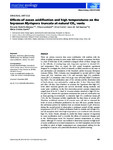Effects of ocean acidification and high temperatures on the bryozoan<i>Myriapora truncata</i>at natural CO<sub>2</sub>vents
| dc.contributor.author | Rodolfo-Metalpa, R | |
| dc.contributor.author | Lombardi, C | |
| dc.contributor.author | Cocito, S | |
| dc.contributor.author | Hall-Spencer, Jason | |
| dc.contributor.author | Gambi, MC | |
| dc.date.accessioned | 2013-02-20T09:13:10Z | |
| dc.date.available | 2013-02-20T09:13:10Z | |
| dc.date.issued | 2010-01 | |
| dc.identifier.issn | 0173-9565 | |
| dc.identifier.issn | 1439-0485 | |
| dc.identifier.uri | http://hdl.handle.net/10026.1/1336 | |
| dc.description.abstract |
There are serious concerns that ocean acidification will combine with the effects of global warming to cause major shifts in marine ecosystems, but there is a lack of field data on the combined ecological effects of these changes due to the difficulty of creating large-scale, long-term exposures to elevated CO2 and temperature. Here we report the first coastal transplant experiment designed to investigate the effects of naturally acidified seawater on the rates of net calcification and dissolution of the branched calcitic bryozoan Myriapora truncata (Pallas, 1766). Colonies were transplanted to normal (pH 8.1), high (mean pH 7.66, minimum value 7.33) and extremely high CO2 conditions (mean pH 7.43, minimum value 6.83) at gas vents off Ischia Island (Tyrrhenian Sea, Italy). The net calcification rates of live colonies and the dissolution rates of dead colonies were estimated by weighing after 45 days (May-June 2008) and after 128 days (July-October) to examine the hypothesis that high CO2 levels affect bryozoan growth and survival differently during moderate and warm water conditions. In the first observation period, seawater temperatures ranged from 19 to 24 °C; dead M. truncata colonies dissolved at high CO2 levels (pH 7.66), whereas live specimens maintained the same net calcification rate as those growing at normal pH. In extremely high CO2 conditions (mean pH 7.43), the live bryozoans calcified significantly less than those at normal pH. Therefore, established colonies of M. truncata seem well able to withstand the levels of ocean acidification predicted in the next 200 years, possibly because the soft tissues protect the skeleton from an external decrease in pH. However, during the second period of observation a prolonged period of high seawater temperatures (25-28 °C) halted calcification both in controls and at high CO2, and all transplants died when high temperatures were combined with extremely high CO2 levels. Clearly, attempts to predict the future response of organisms to ocean acidification need to consider the effects of concurrent changes such as the Mediterranean trend for increased summer temperatures in surface waters. Although M. truncata was resilient to short-term exposure to high levels of ocean acidification at normal temperatures, our field transplants showed that its ability to calcify at higher temperatures was compromised, adding it to the growing list of species now potentially threatened by global warming. © 2010 Blackwell Verlag GmbH. | |
| dc.format.extent | 447-456 | |
| dc.language | en | |
| dc.language.iso | en | |
| dc.publisher | Wiley | |
| dc.subject | Bryozoan | |
| dc.subject | calcification | |
| dc.subject | global warming | |
| dc.subject | Mediterranean Sea | |
| dc.subject | Myriapora truncata | |
| dc.subject | ocean acidification | |
| dc.subject | volcanic CO2 vents | |
| dc.title | Effects of ocean acidification and high temperatures on the bryozoan<i>Myriapora truncata</i>at natural CO<sub>2</sub>vents | |
| dc.type | journal-article | |
| dc.type | Journal Article | |
| plymouth.author-url | https://www.webofscience.com/api/gateway?GWVersion=2&SrcApp=PARTNER_APP&SrcAuth=LinksAMR&KeyUT=WOS:000280671300006&DestLinkType=FullRecord&DestApp=ALL_WOS&UsrCustomerID=11bb513d99f797142bcfeffcc58ea008 | |
| plymouth.issue | 3 | |
| plymouth.volume | 31 | |
| plymouth.publication-status | Published | |
| plymouth.journal | Marine Ecology | |
| dc.identifier.doi | 10.1111/j.1439-0485.2009.00354.x | |
| plymouth.organisational-group | /Plymouth | |
| plymouth.organisational-group | /Plymouth/Faculty of Science and Engineering | |
| plymouth.organisational-group | /Plymouth/Faculty of Science and Engineering/School of Biological and Marine Sciences | |
| plymouth.organisational-group | /Plymouth/PRIMaRE Publications | |
| plymouth.organisational-group | /Plymouth/REF 2021 Researchers by UoA | |
| plymouth.organisational-group | /Plymouth/REF 2021 Researchers by UoA/UoA07 Earth Systems and Environmental Sciences | |
| plymouth.organisational-group | /Plymouth/Research Groups | |
| plymouth.organisational-group | /Plymouth/Research Groups/Marine Institute | |
| plymouth.organisational-group | /Plymouth/Users by role | |
| plymouth.organisational-group | /Plymouth/Users by role/Academics | |
| dc.identifier.eissn | 1439-0485 | |
| dc.rights.embargoperiod | Not known | |
| rioxxterms.versionofrecord | 10.1111/j.1439-0485.2009.00354.x | |
| rioxxterms.licenseref.uri | http://www.rioxx.net/licenses/all-rights-reserved | |
| rioxxterms.type | Journal Article/Review |


